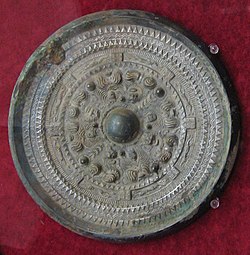銅鏡
Appearance
See also: 铜镜
Chinese
[edit]| copper | mirror | ||
|---|---|---|---|
| trad. (銅鏡) | 銅 | 鏡 | |
| simp. (铜镜) | 铜 | 镜 | |
Pronunciation
[edit]- Mandarin
- (Standard Chinese)+
- Hanyu Pinyin:
- Zhuyin: ㄊㄨㄥˊ ㄐㄧㄥˋ
- Tongyong Pinyin: tóngjìng
- Wade–Giles: tʻung2-ching4
- Yale: túng-jìng
- Gwoyeu Romatzyh: torngjinq
- Palladius: тунцзин (tunczin)
- Sinological IPA (key): /tʰʊŋ³⁵ t͡ɕiŋ⁵¹/
- (Standard Chinese)+
- Hakka
- (Sixian, incl. Miaoli and Neipu)
- Pha̍k-fa-sṳ: thùng-kiang
- Hakka Romanization System: tungˇ giang
- Hagfa Pinyim: tung2 giang4
- Sinological IPA: /tʰuŋ¹¹ ki̯aŋ⁵⁵/
- (Sixian, incl. Miaoli and Neipu)
- Middle Chinese: duwng kjaengH
Noun
[edit]銅鏡
Japanese
[edit]| Kanji in this term | |
|---|---|
| 銅 | 鏡 |
| どう Grade: 5 |
きょう Grade: 4 |
| on'yomi | |
Etymology
[edit]From Middle Chinese compound 銅鏡 / 铜镜 (dhung kjængH, “bronze mirror”).
Pronunciation
[edit]Noun
[edit]銅鏡 • (dōkyō) ←どうきやう (doukyau)?
References
[edit]Categories:
- Chinese lemmas
- Mandarin lemmas
- Hakka lemmas
- Middle Chinese lemmas
- Chinese nouns
- Mandarin nouns
- Hakka nouns
- Middle Chinese nouns
- Chinese terms with IPA pronunciation
- Chinese terms spelled with 銅
- Chinese terms spelled with 鏡
- Japanese terms spelled with 銅 read as どう
- Japanese terms spelled with 鏡 read as きょう
- Japanese terms read with on'yomi
- Japanese terms derived from Middle Chinese
- Japanese terms with IPA pronunciation
- Japanese lemmas
- Japanese nouns
- Japanese terms spelled with fifth grade kanji
- Japanese terms spelled with fourth grade kanji
- Japanese terms with 2 kanji



